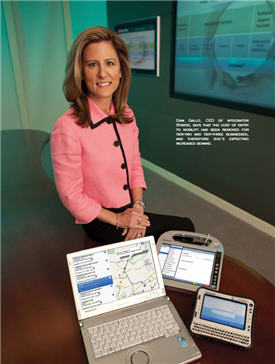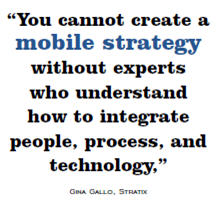Mobility Goes Mainstream
By Gennifer Biggs, Business Solutions magazine.
For those integrators that earned their reputations with rugged mobility, the impact of consumerism and convergence brings new opportunity.

Well-established enterprise mobility integrator Stratix has watched with interest as the trends of converging technology and consumerism swept through the industries on which it concentrates, opening up entirely new opportunities for growth. Meanwhile, CEO Gina Gallo has positioned her organization to be on the cutting edge of the next trend she sees coming: Mobility-as-a-Service (MaaS). After opening its doors in 1983, Stratix built a stellar reputation as a rugged Mobility-as-a-Service (MaaS).
After opening its doors in 1983, Stratix built a stellar reputation as a rugged mobility expert serving enterprise organizations in the manufacturing, retail, and transportation/logistics verticals. Positioned as a consultative partner for customers, Stratix solutions often extended from a manufacturer’s warehouse to the shelves of retailers, providing the integrator with a unique view of the entire supply chain — from bar code labels and mobile handhelds for data capture to shipping logistics and inventory management. “We became knowledgeable about the complexities of the supply chain, and we were well-positioned as a solutions integrator in the rugged mobile data capture space,” explains Gallo. Then, as wireless capabilities increased and mobile advances offered additional value to businesses, Stratix continued to deepen its mobility capabilities while scanning the horizon for new and innovative ways to serve its customers.
Serve Customers By Evolving Mobile Offerings
With that future-focused approach to technology, it is no surprise that Stratix saw today’s consumer-driven mobility trend long before it hit. “Several years ago, we noticed enterprises piloting consumer technology outside the traditional rugged mobile areas of their business, and we realized this was not just a trend. IT departments were no longer able to control the adoption of consumer technology running line-of-business applications,” explains Gallo. As Stratix recognized this shift as an opportunity, Gallo positioned it to address the integration of consumer and rugged mobile strategies within the enterprise. Driving that need was the impact of technology convergence on traditional IT organizations. Consumerism and the impact of “bring your own device” (BYOD) strategies created a shift in power from the IT department to the end users. “IT is no longer alone in making the technology decisions, but rather operations is driving the mobile demand and the technology requirements, while IT is expected to support and manage the visibility into their enterprise’s mobile assets and usage,” explains Gallo. She adds that even with internal IT staff in place, enterprise customers have limited expertise around supporting multi- OS consumer products, and suddenly IT support teams were bogged down by interoperability and integration issues. That gap in internal expertise swung wide open a door in which Stratix had already wedged its foot. “Since we were already serving their rugged mobile needs, we were the logical choice to step up and resolve these new mobile demands.”
Offer Flexibility, Mobile Management To Customers
To accomplish the absorption of consumer enterprise mobility into its commercial rugged mobility portfolio, Stratix developed a platform for handling mobility that runs the gamut from acquisition to configuration to delivery, with support services throughout the entire life cycle of the mobility deployment. The end result is the integrator’s MaaS solution offering, which allows users to pay as they go and swap out technology as innovation brings better solutions to market. “We aren’t here to just integrate, we want to help our customer innovate,” says Gallo. “To do that, we needed to figure out how to provide an experience that enables our customers to leverage the best technology for their business today but with the flexibility to integrate new technology as it evolves.” Therefore, Stratix created a mobile solution as flexible as the incredibly agile mobile marketplace.
Today, when rugged mobile is the answer, Stratix offers its customers a comprehensive solution that includes hardware, software, networking infrastructure, and technical support services. When consumer mobility solutions are the right fit, Stratix leverages its current infrastructure and enterprise mobile expertise to determine the right tool, whether it is smartphones, tablets, and/or laptops, and then has those devices available for immediate configuration and deployment. The integrator supports the mobile devices from integration and deployment, including the coordination of firmware updates, application deployment, and spare pool management. With this hybrid model, Stratix can offer customers access to the latest consumer and rugged solutions, configured for business use, and support for seamless connectivity and constant productivity — all integrated for a positive end user experience. “We provide ROI by keeping working devices in the hands of our customer’s employees, which is essential, because the biggest driver behind mobility is productivity,” says Gallo. With the help of its existing customer portal, Stratix provides their customers 24/7 support and visibility into their mobile assets. Because of the rapid changes in the consumer electronics market, providing support staff trained on everything from iOS, Android, and Windows platforms to managing firmware upgrades is a unique value that Stratix offers its customers.
To create a mobility platform that comprehensive, Stratix invested heavily in both IT infrastructure and human capital. Stratix has acquired people who have experience not only with mobility but also with operations in each vertical it serves. Stratix has a leadership team built with talent from Fortune 500 firms that include software, OEM, and investment companies. “You cannot create a mobile strategy without experts who understand how to integrate people, process, and technology,” says Gallo. Even for Stratix, a $150 million integrator with nearly three decades of in-house data capture expertise, tackling today’s consumer mobile technology frenzy in the enterprise market was a challenge. Stratix waited two decades before betting big on the mobile and wireless industry. That bet paid off, however; after the current leadership team was on-boarded in 2004, the company went through a hyper-growth stage, growing 300% from 2004 to 2008.

Gallo warns solutions providers intrigued by mobility that success in the mobile marketplace takes industry experience, proven execution, and a solid reputation within the partner and customer community. Thought leadership also has to extend well beyond mobile technology, because mobility is, at its root, a highly consultative engagement. That expertise comes at a steep price tag, however, and with the continuous challenge of identifying and hiring the right people. “An integrator’s value is based not only upon their ability to articulate and deliver an enterprise mobile strategy, but their continued thought leadership around the ways technology interdependencies, coupled with economic market shifts, can drive continuous business value,” stresses Gallo.
Turn Mobility Into A Differentiator
With the platform in place to offer a turnkey, managed mobility solution to its customers, Stratix expects to see two areas of strong growth moving forward. Current customers for whom Stratix had provided rugged mobility support over the years are now asking the integrator to take over their mobile consumer technology needs. Gallo points out that is a ripe market for Stratix because, while consumer devices are less expensive, the price for managing and optimizing consumer technology remains the same as that of rugged devices. Services to support mobility can become a large recurring revenue stream for a solutions provider, with margins that can triple those achieved with technology resale.
The second area of growth Stratix expects to see take root in the next few months is tied to midmarket organizations. “We traditionally serve tier-one customers, but the cost of entry to mobility has been removed for smaller companies, and so we are expecting to see similar demands from tier-two and tier-three businesses,” explains Gallo. The midmarket organizations have the same need for the advantages provided by mobility as do large enterprises. While the barrier of entry for cost of technology has been lowered, the midtier market still lacks the IT infrastructure to deploy and support a mobile strategy that can scale. “Midmarket companies are very keen to find a partner they can pay on a monthly basis to handle the mobile strategy end-to-end, so we feel our Mobility-as-a-Service fits them well.”
Overall, Gallo says she expects consumerism to revitalize the rugged market as the more traditional vendors strive to offer the features of today’s consumer devices in tougher form factors. Mobility in the enterprise used to comprise narrow deployments with rugged mobile devices, delivered into specific areas of a business; today, Gallo says, Stratix operates under the assumption that everyone in every company is a mobile user in some way or another. Her stance is supported by research from IDC that predicts that the number of smartphones and tablets utilized within enterprise environments could grow to number 140 million devices by 2013, with at least 50% of enterprise users primarily using a tablet or mobile device by 2016. The question for you is, how do you meet the needs of those customers? Gallo recommends solutions providers create a strategy for meeting their customers’ mobility needs that focuses on partnering rather than a proprietary offering built from scratch. “When you talk about mobile strategy, you are talking about stitching together 8 to 10 providers, and that is a tremendous challenge,” she says. “We spend a tremendous amount of time identifying partners we can rely on for offering complementary technology and services that will meet our customers’ ongoing mobile needs. Customers know there is no silver bullet, so we focus on creating and managing a solution ecosystem that delivers the best customer experience.”

